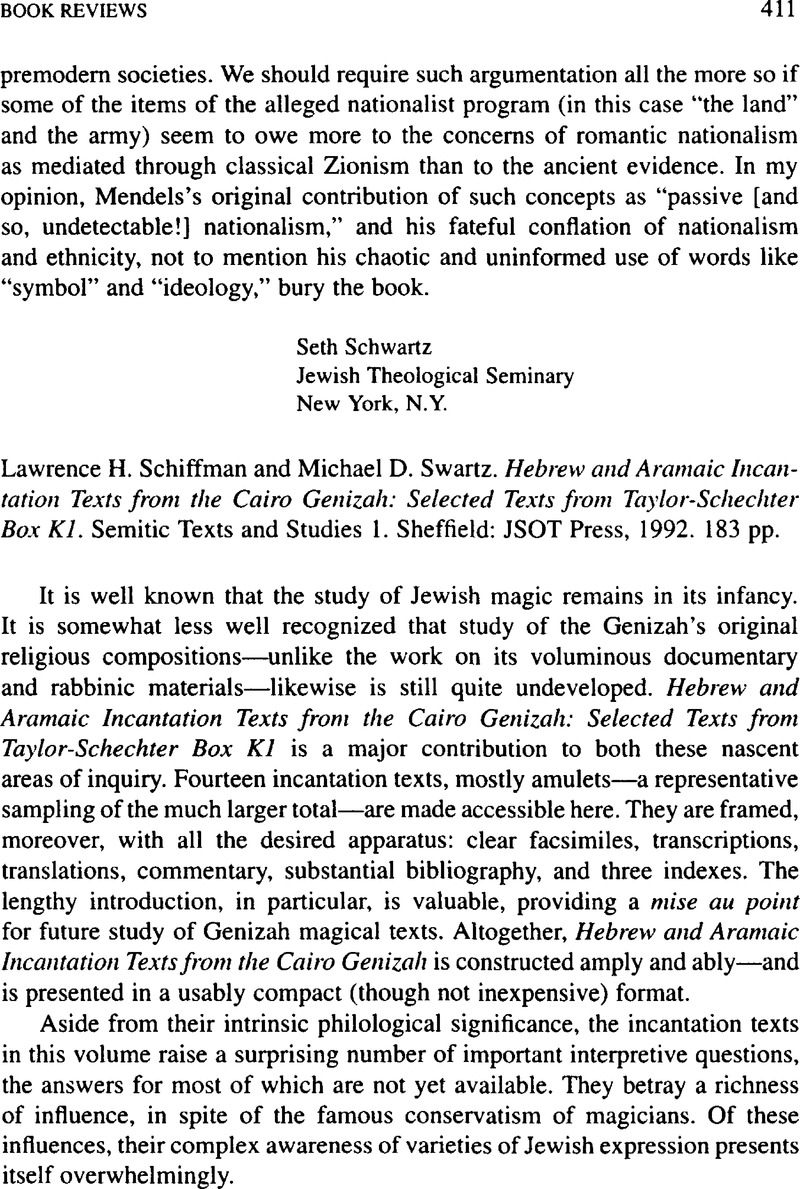No CrossRef data available.
Article contents
Lawrence H. Schiffman and Michael D. Swartz. Hebrew and Aramaic Incantation Texts from the Cairo Genizah: Selected Texts from Taylor-Schechter Box Kl. Semitic Texts and Studies 1. Sheffield: JSOT Press, 1992. 183 pp.
Published online by Cambridge University Press: 15 October 2009
Abstract

- Type
- Book Reviews
- Information
- Copyright
- Copyright © Association for Jewish Studies 1995
References
1. First names found here are common to the Genizah folk, but the amulets identified parties by the mother′s name (p. 45). This would seem to have adhered to a magical procedure standard in the region. See Goldziher, Ignaz, “Hebraische Elemente in muhammedanischen Zaubersprilchen,” Zeitschrift der Deutschen Morgenlaendischen Gesellschaft 48 (1894): 348–350, esp. 350.Google Scholar
2. On the shir shel pega′im (Pss. 91 and 3) at Qumran and in rabbinic sources, see Nitzan, Bilha, “Hymns from Qumran to Frighten and Drive Away Evil Ghosts,” Tarbiz 55 (1985): 19–46 [Hebrew], and the comments in the following issue by Israel Ta-Shema and Joseph M. Baumgarten.Google Scholar
3. A facsimile and discussion can be found in Zafrani, Haim, Kabbale, vie mystique et magie (Paris: Maisonneuve & Larose, 1986), pp. 407–408.Google Scholar
4. For example, the materials collected and presented in the catalogue, Magic and Superstition in the Jewish Tradition, introductory materials by Arthur M. Feldman, Marcia Reines Josephy, and David Weinstein (Chicago: Spertus College of Judaica Press, 1975).Google Scholar
5. Philippe Gignoux, Incantations magiques syriaques (Louvain: E. Peeters, 1987).Google Scholar
6. Ibid., p. 3.
7. Jonas Greenfield, “Notes on Some Aramaic and Mandaic Magic Bowls,” Journal of the Near East Society of Columbia University 5 (1973): 154–156.Google Scholar
8. Israel Friedlander, “A Muhammadan Book of Augury in Hebrew Characters,” Jewish Quarterly Review, o.s. 19 (1907): 84–103.Google Scholar
9. Shaul Snaked and Joseph Naveh, Amulets and Magic Bowls: Aramaic Incantations from Late Antiquity (Jerusalem, 1985), p. 18.Google Scholar
10. Muriel Djeribi, “L′incantation tnythique: noms et ecriture,” Ethnologie frwiqaise 23 (1993): 94–103.Google Scholar
11. J. Trachtenberg, Jewish Magic and Superstition: A Study in Folk Religion (New York, 1939)Google Scholar


